In-Depth Exploration of White Birds: Traits and Habitats


Intro
White birds captivate many individuals with their serene appearance and distinct characteristics. This article seeks to provide an exploration of these remarkable avian species, focusing on their traits, habitats, and significance both in the wild and as pets. As we delve into this topic, the aim is to foster a deeper understanding of these birds, which play vital roles in ecosystems and cultures alike.
The examination covers various species, their ecological importance, and practical insights for potential pet owners. By engaging with the content, readers will discover not only the beauty of white birds but also their unique care requirements and the conservation issues they face today.
Understanding Your Pet
In the context of white birds, understanding them as pets is essential for their well-being and your own satisfaction.
Pet Behavior Basics
White birds like the Cockatoo or the Cockatiel exhibit diverse behaviors. They can be social, enjoying interaction with humans or other birds. These birds often form strong bonds with their owners, which can influence their general demeanor and well-being. An understanding of avian body language is crucial for recognizing comfort levels and stress signals.
Common Breed Characteristics
Different species of white birds have unique traits:
- Cockatoos: Known for their expressive crests and sociable nature, these birds can be quite vocal.
- Doves: Typically quieter and more reserved, doves are often gentle companions.
- Parakeets: Energetic and playful, these small birds often require more social stimuli.
Species-Specific Needs
Specific species come with their own needs. For instance, Cockatoos may require more space and mental stimulation, while doves prefer quieter, more secluded areas. Understanding individual needs helps in providing better care.
Pet Care and Maintenance
Ensuring proper care for white birds leads to healthier and happier pets.
Feeding Guidelines
Offering a balanced diet is critical. Most white birds thrive on a mixture of seeds, fruits, and vegetables. For example, Cockatiels benefit from a seed mix supplemented by leafy greens.
Grooming Essentials
Regular grooming is essential. Many white birds, such as Cockatoos, require nail trimming and beak maintenance. Additionally, bathing encourages hygiene and can be a fun activity.
Hygiene Practices
Maintaining a clean living environment is necessary. Regularly clean cages and replace bedding. This helps prevent disease and promotes a comfortable habitat.
Training and Development
Training white birds can foster engagement and improve behavior.
Basic Commands and Skills
Teaching simple commands can enhance communication. Words like “come” or “step up” can be learned through repetition and positive reinforcement.
Behavioral Training Techniques
Using methods such as clicker training helps in establishing a bond. Birds respond well to positive feedback, which can assist in correcting unwanted behaviors.
Addressing Common Behavior Issues
Common issues such as biting or loud vocalizations can be addressed through consistent training and understanding triggers. Patience is key.
Health and Wellness
Proper health maintenance is necessary for white birds.
Routine Vet Check-ups
Regular visits to an avian vet are essential for prevention and early detection of health issues. Annual check-ups can significantly improve longevity.
Vaccination Needs
Vaccinations can protect against common avian diseases. Consulting with a vet helps ensure your bird receives the necessary immunizations.
Recognizing Signs of Illness
Awareness of symptoms such as changes in appetite or behavior can lead to timely intervention. Early detection often improves treatment outcomes.
Enrichment and Activities
Providing stimulation is important for mental health.
Indoor vs.
Outdoor Activities
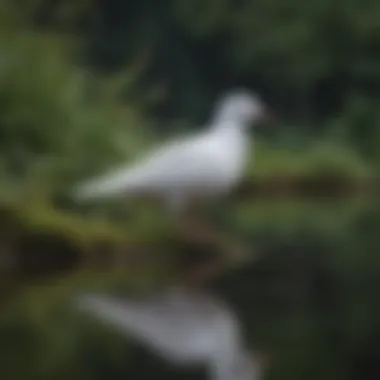
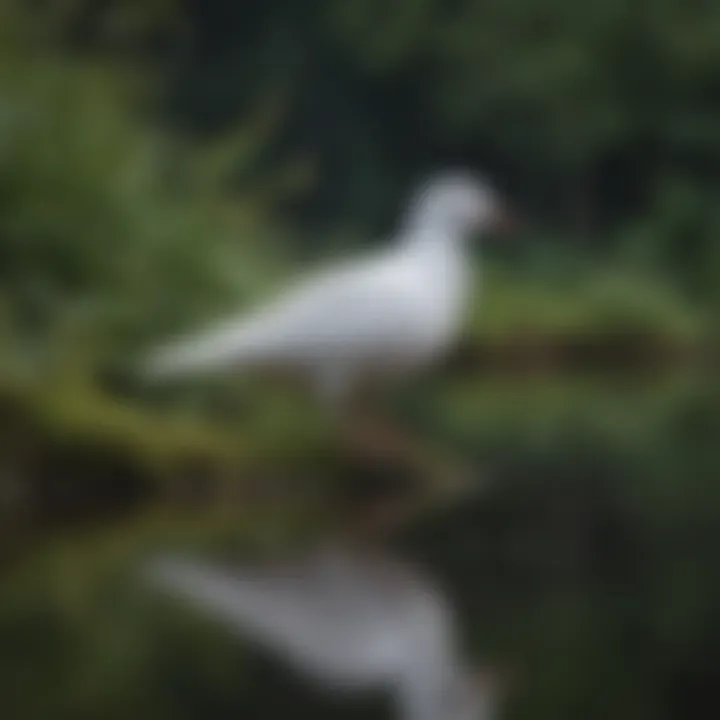
Creating a safe indoor environment allows for play without exposure to dangers of the outdoors. However, supervised time outdoors can be beneficial for their well-being.
Interactive Toys and Games
Engaging toys stimulate curiosity and activity. Mirrors, swings, and foraging toys can keep birds mentally sharp.
Socialization Opportunities
Social interaction is essential. Multiple pets can enrich a bird's life, provided they are introduced carefully.
Understanding and catering to the needs of white birds not only enhances their lives but also deepens the bond between pet and owner.
This exploration into the features and care of white birds serves as a guide for those who appreciate their splendor and seek to provide a nurturing environment.
Prolusion to White Birds
Defining White Birds
White birds, as the term suggests, are avian species characterized by their predominantly white plumage. This group encompasses a wide range of species found in various environments across the globe, from coastal regions to woodlands. Notably, many of these birds exhibit striking physical features that distinguish them not only from each other but also from their more colorful counterparts. The color white in birds can be attributed to several factors, including genetics and habitats, providing insights into their survival strategies and evolutionary adaptations.
Diving deeper, it becomes clear that the term "white birds" is not merely a description of their color but also indicative of their ecological roles and behaviors. Some well-known examples include the elegant swan, the graceful egret, and the ubiquitous seagull. Each of these species carries its own unique set of characteristics that contribute to the biodiversity of their respective ecosystems.
Importance in Ecosystems
White birds play critical roles in maintaining the balance of various ecosystems. They can act as both predators and prey, contributing to food web dynamics. For instance, species like the egret feed on insects and small fish, thus helping to control their populations. Their feeding habits can promote healthier aquatic environments and prevent overpopulation of certain species.
Moreover, white birds can serve as indicators of environmental health. A decline in their populations can signal issues such as habitat destruction or pollution, making their conservation crucial for ecosystem stability. The presence of these birds often correlates with rich biodiversity, as their habitats typically support a variety of other species.
In summary, defining and understanding white birds is not solely about their appearance. It involves appreciating their ecological contributions and the significance they hold within their environments. By recognizing these factors, we can better appreciate the intricate networks of life that these avian species are a part of and the need for their protection.
Key Characteristics of White Birds
The study of white birds encompasses their unique physical and behavioral traits. Understanding these characteristics is crucial for appreciating their roles in various ecosystems. This section provides insights into what sets white birds apart from other avian species, emphasizing aspects important for pet owners and nature enthusiasts alike.
Physical Attributes
White birds exhibit a range of physical attributes that make them distinct and recognizable. This includes their plumage, size, and beak shape.
- Plumage: The most defining characteristic is their white feathers, which can reflect light in such a way as to look almost luminescent. Some species, like the mute swan, display subtle variations in white shades, which may serve as camouflage in specific habitats or situations.
- Size: The size of white birds varies considerably. For example, the great egret can reach impressive heights, around 38 inches, while smaller species like the white-throated sparrow may only be about 6 to 7 inches long.
- Beak Shape: The beak shape can also vary. Long, pointed beaks are common in birds such as egrets, which facilitate fishing and foraging. In contrast, the stout beaks of doves allow for seed-crushing, showcasing how physical attributes align with their dietary needs.
Understanding these physical traits can assist potential bird owners in choosing a species appropriate for their environment, ensuring a harmonious coexistence.
Behavioral Traits
The behavioral characteristics of white birds add another layer to their significance in ecosystems. These traits vary widely across different species, impacting their survival and interactions with other organisms.
- Feeding Habits: White birds often exhibit specialized feeding habits. For instance, seagulls are known for their opportunistic eating, while swans primarily graze on water plants. Understanding these habits can guide pet owners on what to feed their birds if they choose to keep them.
- Social Structures: Many white bird species are social creatures. Egrets, for example, often gather in large colonies during breeding seasons. In contrast, doves may prefer the company of a mate or small groups. Observing these social behaviors can enhance one's appreciation of their complexities.
- Migration Patterns: Some white birds, like the Arctic tern, are famous for their long migrations. Understanding these patterns can lend insight into the environmental conditions that white birds require for survival and reproduction.
Important Note: Understanding both physical and behavioral characteristics of white birds enhances our appreciation for their roles in nature. Responsible stewardship is key to ensuring their continued presence in ecosystems.
In summary, recognizing the unique traits of white birds aids in their conservation and can enrich our interactions, whether in the wild or as pets.
Diversity Among White Bird Species
Diversity among white bird species is crucial for understanding their roles within various ecosystems. Each species contributes uniquely through different ecological functions and adaptations. Recognizing this diversity helps in appreciating their significance beyond their color. The varied characteristics of these birds illustrate how they adapt to environmental pressures and niches.
Common Species Overview
Egrets
Egrets are a group of long-legged birds known for their striking white plumage. They often inhabit wetlands and are essential for controlling fish populations. Their graceful hunting technique allows them to catch prey efficiently. Egrets are a beneficial choice for studying white birds due to their adaptive significance in aquatic environments.
Their ability to blend in with their surroundings makes them efficient predators, which benefits ecosystem balance. However, egrets are sensitive to habitat disturbance, making their presence an indicator of environmental health.
Swan
Swans are large waterfowl that symbolize beauty and tranquility. They are often found in lakes and rivers and are known for their loyalty, frequently forming monogamous pairs. Their impressive size and elegant movements in water make them a popular focus in studies about aquatic avifauna. Swans play a role in aquatic ecosystems by grazing on vegetation, helping maintain the balance of aquatic plant life.
One unique feature is their adaptability to both wild and controlled environments, providing advantages in terms of conservation and observation. However, they can also be threatened by pollution and habitat loss, which complicates their conservation efforts.
Seagulls
Seagulls are highly adaptable birds and can thrive in diverse environments including coastlines and urban settings. They are opportunistic feeders, which enhances their survival in fluctuating ecosystems. As scavengers, seagulls contribute to nutrient cycling. They are often seen as indicators of marine health, benefiting this article's focus on ecosystem dynamics.
A unique aspect of seagulls is their intelligence, which allows them to exploit various food sources. However, this adaptability can lead to conflicts with humans, especially in urban landscapes.
Doves
Doves are gentle birds often associated with peace and love. They can thrive in a range of environments, from urban areas to wild forests. Their cooing sounds and social behavior create a calming presence, making them popular as pets. Doves are highly beneficial as they help in seed dispersal, playing a role in plant reproduction.
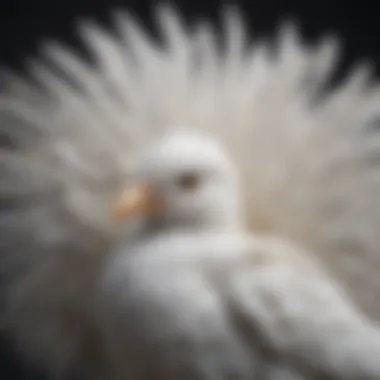
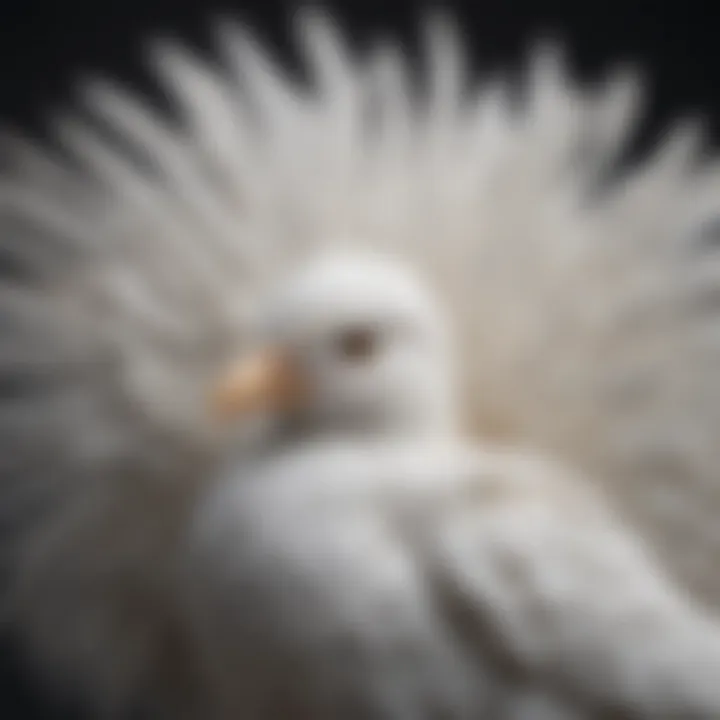
One distinctive feature is their ability to adapt to different habitats, which provides an opportunity for study in varying contexts. However, their presence can also attract predators, making their survival in certain regions challenging.
Rare White Bird Species
Albino Variations
Albino variations of white birds, while rare, can offer valuable insights into genetics and adaptation in wildlife. The absence of pigment causes their feathers to be strikingly white, making them visually different from other white birds. Their occurrences in natural populations help studies related to genetic diversity.
Despite their uniqueness, albino birds may face challenges in the wild, such as increased visibility to predators. There is also a concern regarding their health, as certain environmental factors can affect them more severely due to their lack of pigmentation.
Specialized Habitats
White birds that occupy specialized habitats, like the snowy owl found in tundra environments, are vital for understanding avian adaptability. These birds have unique adaptations suited to their specific ecological niches. Studying them contributes to knowledge about habitat preservation and the importance of maintaining diverse ecosystems.
The unique feature of such birds is their specialized hunting and foraging behaviors, tailored to survive in extreme conditions. However, their specific habitat requirements can make them vulnerable to climate change and habitat destruction.
Habitats of White Birds
Understanding the habitats of white birds is crucial for appreciating their ecological roles and the dynamics of their populations. Each habitat offers specific resources and challenges, influencing the behavior and distribution of various species. White birds, which include egrets, swans, and doves, have different adaptations that allow them to thrive in their respective environments. This section will explore the three main types of habitats where white birds are often found: aquatic environments, terrestrial habitats, and urban adaptations.
Aquatic Environments
Aquatic environments are vital for many white bird species. These areas provide essential resources such as food, nesting sites, and shelter. Wetlands, lakes, rivers, and coastal regions play host to various species, including egrets and swans. Water bodies support diverse food sources, such as fish, amphibians, and invertebrates, which are key components of the diet for these birds.
Types of Aquatic Habitats:
- Freshwater Lakes: Important for species like the mute swan and great egret.
- Estuaries: Transitional areas rich in nutrients, perfect for hunting.
- Coastal Areas: Serve as feeding grounds with abundant marine life.
These aquatic environments also develop unique ecosystems that support flora and fauna, promoting biodiversity. However, they are susceptible to pollution and habitat destruction, making it critical to preserve them for the wellbeing of white birds and the broader ecosystem.
Terrestrial Habitats
Terrestrial habitats encompass varied landscapes, including grasslands, forests, and fields. These areas are essential for white bird species, such as doves and some types of gulls. They provide nesting locations and foraging opportunities. In forests, for example, tree cavities can serve as nesting sites, while open fields might offer seeds and small insects for food.
Key Features of Terrestrial Habitats:
- Open Fields: Favored by ground-nesting doves. Here, they can find seeds easily.
- Woodlands: Provide ample hiding places from predators and nesting opportunities.
- Grasslands: Support various insects critical for feeding young birds.
These habitats are integral for breeding and survival. The loss of such environments, due to urbanization or agriculture, poses a significant threat to many white bird species.
Urban Adaptations
Urban environments have increasingly become significant habitats for various white bird species. As cities expand, many birds like seagulls and certain doves adapt remarkably well to human-altered landscapes. Urban areas provide unique challenges but also abundant opportunities for food and nesting.
Characteristics of Urban Habitats:
- Food Availability: Garbage and food scraps provide a steady food source for adaptable species.
- Nesting Sites: Buildings and bridges can offer nesting spots that mimic cliffs or tree branches.
- Water Sources: Ponds and artificial lakes create additional habitats within city spaces.
While urbanization does impact natural habitats negatively, it has also demonstrated how certain species can thrive in modified environments. Understanding these adaptations can lead to better urban planning that accommodates wildlife needs.
By maintaining diverse habitats, we can ensure the sustainability of white bird populations and the overall health of ecosystems.
Cultural Significance of White Birds
White birds hold substantial cultural significance across various societies. Their representation in folklore, religious beliefs, and artistic expressions emphasizes their role as symbols. Knowledge and appreciation of their meanings can enrich our understanding of not only white birds but also human culture itself.
Symbolism in Various Cultures
Throughout different cultures, white birds often symbolize purity, peace, and freedom. For example, in many Western cultures, the white dove is used as a symbol of peace. Its image is commonly associated with love and harmony. Similarly, in Christianity, the dove embodies the Holy Spirit and is a representation of divine promise.
In Eastern cultures, specific white birds continue to represent significant beliefs and values. For instance, the white crane denotes longevity and wisdom in Asian traditions. Its graceful presence invites reflection on the beauty of life and harmony with nature. Moreover, in Native American culture, certain tribes view the snowy owl as a sacred messenger, emphasizing the connection between the spiritual and physical worlds.
This symbolism often influences art, literature, and various cultural narratives. Understanding these meanings can help people recognize the broader context of their existence and significance within different societies.
White Birds in Literature and Art
White birds appear frequently in literature and art, often embodying deeper themes. In literature, they are often used as metaphors. Their flight can symbolize aspirations and the quest for freedom. For example, in many famous poems, a white bird in flight is depicted as a representation of unbounded potential and hope. Such imagery encourages readers to contemplate their own desires for liberation.
In the art world, white birds grace canvases in forms ranging from abstract representations to hyper-realistic portrayals. Artists, like John James Audubon, showcased various bird species, drawing attention to their beauty and fragility. Moreover, white birds often populate traditional paintings, contributing to themes of tranquility and nature’s majesty.
This ongoing depiction illustrates the enduring relationship between white birds and humanity’s creative expression. Their allure will likely continue to inspire future generations of artists, allowing the cultural significance of white birds to evolve as society changes.
“White birds not only enrich ecosystems, they also enhance cultural narratives, bridging the gap between nature and human expression.”
Care Considerations for White Bird Pets
Caring for white birds as pets requires a thoughtful approach, ensuring that their unique needs are met. These avian companions can bring joy and companionship, but their care differs depending on species and environment. Understanding these considerations is essential for anyone looking to keep white birds as pets.
Choosing the Right Species
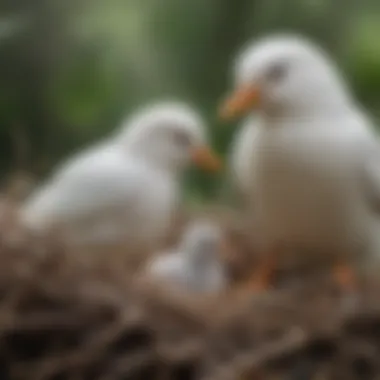
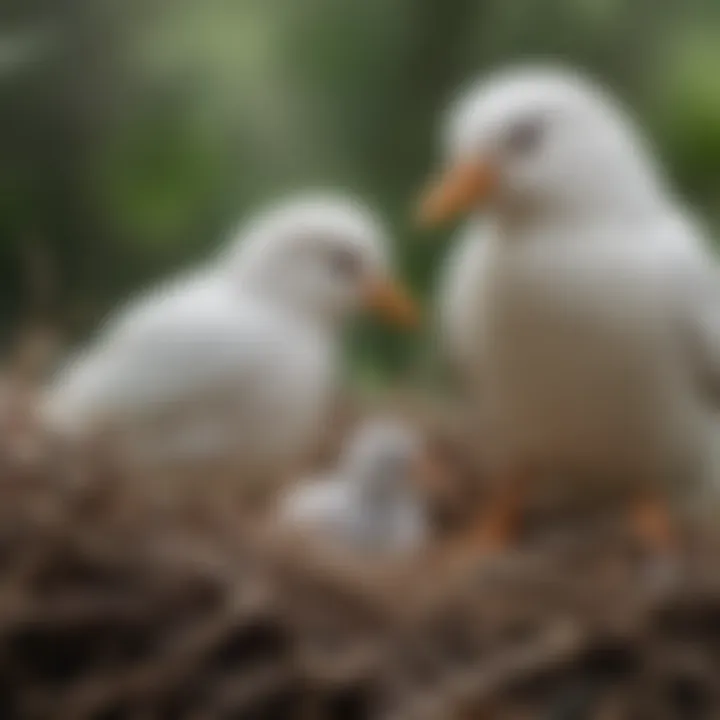
When selecting a white bird to adopt, it's essential to research the various species available. Each species presents distinct characteristics and care requirements. Key factors to consider include:
- Size: Smaller birds like doves may thrive in a limited space, while larger species, such as swans or certain types of gulls, require more room.
- Temperament: Some birds, like the mute swan, may be more solitary, while others, such as doves, generally enjoy social interactions.
- Lifespan: Consider how long you are willing to commit to the pet. Some birds can live for many years, requiring long-term care.
A clear understanding of these elements will help ensure compatibility with your lifestyle and environment.
Essentials of Diet and Nutrition
A balanced diet is critical for the health of white birds. Different species have unique dietary needs, but some general guidelines apply:
- Seeds and Pellets: Many birds benefit from a mix of high-quality seeds and pellets that provide essential nutrients.
- Fresh Fruits and Vegetables: Supplementing their diet with fresh produce can enhance their health. Popular options include spinach, carrots, and apples.
- Clean Water: Fresh water should be readily available at all times. Clean the water container daily to avoid bacterial growth.
It's advisable to consult a veterinarian specialized in avian health to establish a suitable diet for your specific bird species.
Habitat Setup and Maintenance
Proper habitat setup is crucial for the wellbeing of white birds. This involves creating a safe, stimulating environment:
- Cage Size and Type: Choose a cage that fits the bird's size and needs. Ensure it allows for adequate movement and perch space.
- Perches and Enrichment: Install various perches with different diameters and textures. Include toys to keep them mentally stimulated.
- Cleanliness: Regularly clean the habitat to minimize disease risks. Use bird-safe cleaning products and change bedding often.
It's important to make the habitat as natural as possible, as it aids in the psychological health of the bird.
Proper care not only enriches the lives of white birds but also enhances the bond between the pet and owner. Understanding their needs ensures a happy, healthy companionship.
Conservation of White Bird Species
Conservation of white bird species is a crucial aspect of this article, as these birds face numerous challenges that threaten their existence. Their elegant presence is not only significant to our ecosystems but also holds cultural meanings in various societies. It is important to understand the factors endangering these birds and to explore the efforts underway to protect them.
Threats to Populations
White birds encounter a range of threats that can impact their populations. These threats often stem from human activities and environmental changes. Some of the major threats include:
- Habitat Loss: Urbanization and agricultural expansion reduce natural habitats for many white birds. Wetlands, lakes, and coastal areas are particularly affected.
- Pollution: Contaminants in water sources can harm aquatic birds like egrets and swans. Chemicals can lead to disease and reproductive issues.
- Climate Change: Alterations in weather patterns and rising sea levels affect the habitats of many species. For example, migratory routes may be disrupted, complicating their long-term survival.
- Hunting and Poaching: Unsustainable hunting and illegal trapping reduce populations of certain species. Cultural practices or the illegal pet trade are often driving forces behind this.
- Invasive Species: Non-native species can cause competition for food and nesting sites. They can also introduce diseases that local bird populations have not encountered before.
Understanding these threats highlights the urgency of conservation efforts aimed at protecting white birds.
Conservation Efforts
Conservation efforts play a significant role in restoring and maintaining white bird populations. Many organizations and governments are implementing strategies to combat the threats these birds face. Noteworthy efforts include:
- Protected Areas: Establishing and maintaining national parks and wildlife reserves provide safe habitats for various bird species. These areas help mitigate habitat loss, allowing populations to recover.
- Legislation: Enforcing laws that protect endangered species is crucial. International agreements like the Migratory Bird Treaty Act protect migratory birds and their habitats.
- Community Engagement: Educating local communities about the importance of white birds encourages participation in conservation activities. This can include bird watching, habitat restoration efforts, and reporting illegal hunting practices.
- Rescue and Rehabilitation Programs: Organizations often rescue injured or orphaned white birds, providing them with medical care and rehabilitation. Once healthy, these birds may be released back into their natural habitats.
- Research and Monitoring: Continuous monitoring of bird populations helps identify trends and areas that require urgent attention. Research also informs conservation strategies, ensuring they are effective.
Conservation is not just about saving a species; it is about preserving our natural heritage and ecological balance for future generations.
Comparative Analysis of White Birds and Other Avian Species
Differences from Non-White Birds
White birds exhibit several distinct differences when compared to non-white avian species. Primarily, their coloration plays a crucial role in their survival and behavior. Unlike darker birds, which may hide better within certain environments, white birds often stand out. This can have both advantages and disadvantages. For instance, they can be more visible to potential predators in areas with a lot of vegetation. However, their unique plumage can also make them more likely to attract mates.
Another difference lies in their adaptive strategies. Many white birds, such as the snowy egret or tundra swan, are often found in specific habitats that correspond to their feeding and social behaviors. They may be observed in wetland areas or near water bodies. Non-white birds, like robins or crows, can be found in a variety of settings, ranging from urban areas to forests. This habitat preference is a reflection of their ecological niche and feeding habits.
Furthermore, the skin and feather colors of birds influence their thermal regulation. White feathers can reflect sunlight better than darker plumage, which may help them stay cooler in warm climates. In contrast, non-white birds often have darker feathers that can absorb warmth, a benefit in colder regions.
Ecological Roles Compared
White birds play unique roles within their ecosystems that can differ significantly from those of non-white birds. Often, white feathered species serve as indicators of environmental health. Their presence can signal the quality of wetlands and other habitats. For instance, the presence of great egrets can indicate ample fish populations and healthy ecosystems.
In contrast, many non-white birds fill different ecological niches. For example, species like the falcon or hawk are typically predators, while crows may act as scavengers. The ecological roles of white birds are often centered on foraging strategies that involve fishing or wading in shallow waters. This behavior can enhance nutrient cycling in aquatic environments as they may help control fish populations.
White birds are also frequently involved in specific symbiotic relationships. For instance, cattle egrets often follow livestock to feed on insects disturbed by their movement. This relationship aids in pest control and showcases how white birds integrate into agricultural ecosystems.
“Understanding the differences between white birds and their non-white counterparts also highlights the intricate balance of ecosystems.”
Conclusively, the comparative analysis of white birds with other avian species reveals much about their specific adaptations and roles in nature. Such understanding enriches the appreciation of their presence in our surroundings and the intricate interplay of different bird species within ecosystems.
The End and Future Perspectives
In summarizing the findings related to white birds, it becomes clear that these avian species hold unique significance across various ecological and cultural frameworks. The exploration of their characteristics, habitats, and roles enhances our understanding of biodiversity and the delicate balance within ecosystems. Recognizing the symbiotic relationship between these birds and their environments informs conservation efforts, emphasizing the necessity of responsible stewardship.
Additionally, the cultural symbolism associated with white birds, found in various societies, highlights how they serve not only as ecological participants but also as cultural icons. Their representation in literature and art points to a broader human connection with nature, reminding us of the beauty and fragility of wildlife.
The benefits of understanding white birds extend beyond mere observation. Enhanced appreciation can lead to advocacy for their conservation. As we delve into the significance of future research directions, we see a critical need for expanded studies focusing on these birds' behaviors, population dynamics, and habitat resilience amidst changing climates.
Summarizing Key Points
- White birds are diverse in species, each offering distinctive characteristics and behaviors.
- They play crucial roles in ecosystems, aiding in pest control and seed dispersal.
- Their cultural relevance varies worldwide, symbolizing peace, purity, and freedom.
- Conservation initiatives are essential for maintaining white bird populations against threats like habitat loss and climate change.
Future Research Directions
Future studies can focus on several key areas to better understand and protect white birds:
- Behavioral Studies: In-depth research on social behaviors, mating rituals, and feeding patterns could uncover how these birds adapt.
- Climate Impact Analysis: Investigating how climate change affects white bird migratory patterns and breeding grounds will be crucial for conservation strategies.
- Habitat Restoration: Researching effective methods for restoring and maintaining healthy habitats that support diverse white bird species.
- Public Engagement: Programs to raise awareness about white birds can promote conservation efforts and community involvement.
By leveraging existing knowledge and addressing these future research directions, conservationists and ornithologists can create a lasting impact on protecting these magnificent birds. The hope is that through continued interest and research, we can ensure that the beauty and significance of white birds remain an invaluable part of our natural world.







